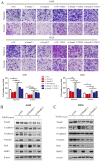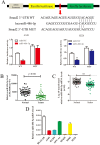Suppression of non-small cell lung cancer migration and invasion by hsa-miR-486-5p via the TGF-β/SMAD2 signaling pathway
- PMID: 31762811
- PMCID: PMC6856587
- DOI: 10.7150/jca.35017
Suppression of non-small cell lung cancer migration and invasion by hsa-miR-486-5p via the TGF-β/SMAD2 signaling pathway
Abstract
Non-small cell lung cancer (NSCLC) is the leading cause of cancer-related death worldwide. SMAD family member 2 (SMAD2) is a key element downstream of the transforming growth factor beta (TGF-β) signaling pathway that regulates cancer metastasis by promoting the epithelial-mesenchyme transition (EMT). MicroRNA miR-486-5p is a tumor suppressor in NSCLC progression. However, it remains unclear whether miR-486-5p is implicated in TGF-β signaling and EMT in NSCLC. In the present study, high expression of SMAD2 mRNA was detected in NSCLC tissues and cell lines, and was associated with poor survival of patients with NSCLC. By contrast, miR-486-5p was downregulated in NSCLC tissues and cell lines. In silico prediction showed that SMAD2 was a potential target of miR-486-5p. The prediction was verified using a dual-luciferase reporter assay. Transwell assays showed that knockdown of SMAD2 inhibited TGF-β-induced EMT and migration and invasion in NSCLC cells. Similarly, miR-486-5p overexpression suppressed TGF-β-induced EMT and migration and invasion of NSCLC cells. The present study provides a new insight into the role of miR-486-5p in regulating TGF-β-mediated EMT and invasion in NSCLC.
© The author(s).
Conflict of interest statement
Competing Interests: The authors have declared that no competing interest exists.
Figures







Similar articles
-
MicroRNA-527 inhibits TGF-β/SMAD induced epithelial-mesenchymal transition via downregulating SULF2 expression in non-small-cell lung cancer.Math Biosci Eng. 2019 May 23;16(5):4607-4621. doi: 10.3934/mbe.2019231. Math Biosci Eng. 2019. PMID: 31499680
-
miR-335-5p inhibits TGF-β1-induced epithelial-mesenchymal transition in non-small cell lung cancer via ROCK1.Respir Res. 2019 Oct 21;20(1):225. doi: 10.1186/s12931-019-1184-x. Respir Res. 2019. PMID: 31638991 Free PMC article.
-
LncRNA NEAT1 promotes proliferation, migration, invasion and epithelial-mesenchymal transition process in TGF-β2-stimulated lens epithelial cells through regulating the miR-486-5p/SMAD4 axis.Cancer Cell Int. 2020 Oct 31;20(1):529. doi: 10.1186/s12935-020-01619-8. Cancer Cell Int. 2020. PMID: 33292220 Free PMC article.
-
Alterations in TGFβ signaling during prostate cancer progression.Am J Clin Exp Urol. 2021 Aug 25;9(4):318-328. eCollection 2021. Am J Clin Exp Urol. 2021. PMID: 34541030 Free PMC article. Review.
-
TGF-β Signaling in Gastrointestinal Cancers: Progress in Basic and Clinical Research.J Clin Med. 2017 Jan 18;6(1):11. doi: 10.3390/jcm6010011. J Clin Med. 2017. PMID: 28106769 Free PMC article. Review.
Cited by
-
Role of miRNA-mRNA Interactome in Pathophysiology of Arrhythmogenic Cardiomyopathy.Biomedicines. 2024 Aug 9;12(8):1807. doi: 10.3390/biomedicines12081807. Biomedicines. 2024. PMID: 39200271 Free PMC article.
-
Integrated spatial analysis of gene mutation and gene expression for understanding tumor diversity in formalin-fixed paraffin-embedded lung adenocarcinoma.Front Oncol. 2022 Nov 24;12:936190. doi: 10.3389/fonc.2022.936190. eCollection 2022. Front Oncol. 2022. PMID: 36505794 Free PMC article.
-
Eurycomanone Blocks TGF-β1-Induced Epithelial-to-Mesenchymal Transition, Migration, and Invasion Pathways in Human Non-Small Cell Lung Cancer Cells by Targeting Smad and Non-Smad Signaling.Int J Mol Sci. 2025 Jul 23;26(15):7120. doi: 10.3390/ijms26157120. Int J Mol Sci. 2025. PMID: 40806251 Free PMC article.
-
MAP3K19 Promotes the Progression of Tuberculosis-Induced Pulmonary Fibrosis Through Activation of the TGF-β/Smad2 Signaling Pathway.Mol Biotechnol. 2024 Nov;66(11):3300-3310. doi: 10.1007/s12033-023-00941-6. Epub 2023 Oct 31. Mol Biotechnol. 2024. PMID: 37906388
-
Transparent sparse graph pathway network for analyzing the internal relationship of lung cancer.Front Genet. 2024 Oct 1;15:1437174. doi: 10.3389/fgene.2024.1437174. eCollection 2024. Front Genet. 2024. PMID: 39411374 Free PMC article.
References
-
- Wrzesinski SH, Wan YY, Flavell RA. Transforming growth factor-beta and the immune response: implications for anticancer therapy. Clinical cancer research. 2007;13:5262–70. - PubMed
LinkOut - more resources
Full Text Sources

